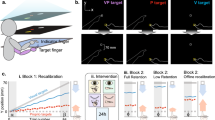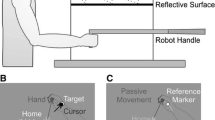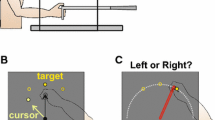Abstract
We estimate our hand’s position by combining relevant visual and proprioceptive cues. A cross-sensory spatial mismatch can be created by viewing the hand through a prism or, more recently, rotating a visual cursor that represents hand position. This is often done in the context of target-directed reaching to study motor adaptation, the systematic updating of motor commands in response to a systematic movement error. However, a visuo-proprioceptive mismatch also elicits recalibration in the relationship between the hand’s seen and felt position. The principles governing visuo-proprioceptive recalibration are poorly understood, compared to motor adaptation. For example, motor adaptation occurs robustly whether the cursor is rotated quickly or slowly, although the former may involve more explicit processes. Here, we asked whether visuo-proprioceptive recalibration, in the absence of motor adaptation, works the same way. Three groups experienced a 70 mm visuo-proprioceptive mismatch about their hand at a Slow, Medium, or Fast rate (0.84, 1.67, or 3.34 mm every two trials, respectively), with no error feedback. Once attained, the 70 mm mismatch was maintained for the remaining trials. Total recalibration differed significantly across groups, with the Fast, Medium, and Slow groups recalibrating 63.7, 56.3, and 42.8 mm on average, respectively. This suggests a slower mismatch rate may be less effective at eliciting recalibration. In contrast to motor adaptation studies, no further recalibration was observed in the maintenance phase. This may be related to the distinct mechanisms thought to contribute to perceptual recalibration via cross-sensory cue conflict versus sensory prediction errors.




Similar content being viewed by others
Availability of data and materials
The data and analysis code used in this manuscript are available at https://osf.io/te4kp/.
References
Abeele S, Bock O (2001) Sensorimotor adaptation to rotated visual input: different mechanisms for small versus large rotations. Exp Brain Res 140:407–410
Alais D, Burr D (2004) The ventriloquist effect results from near-optimal bimodal integration. Curr Biol 14:257–262
van Beers RJ, Sittig AC, van der Gon JJD (1999) Localization of a seen finger is based exclusively on proprioception and on vision of the finger. Exp Brain Res 125:43–49
van Beers RJ, Wolpert DM, Haggard P (2002) When feeling is more important than seeing in sensorimotor adaptation. Curr Biol 12:834–837
Block HJ, Bastian AJ (2010) Sensory reweighting in targeted reaching: effects of conscious effort, error history, and target salience. J Neurophysiol 103:206–217
Block HJ, Bastian AJ (2011) Sensory weighting and realignment: independent compensatory processes. J Neurophysiol 106:59–70
Block H, Bastian A, Celnik P (2013) Virtual lesion of angular gyrus disrupts the relationship between visuoproprioceptive weighting and realignment. J Cogn Neurosci 25:636–648
Block HJ, Liu Y (2023) Visuo-proprioceptive recalibration and the sensorimotor map. J Neurophysiol 129:1249–1258
Block HJ, Sexton BM (2020) Visuo-proprioceptive control of the hand in older adults. Multisensory Research 34:93–111
Butler AA, Héroux ME, Gandevia SC (2017) Body ownership and a new proprioceptive role for muscle spindles. Acta Physiol 220:19–27
Cressman EK, Henriques DYP (2009) Sensory recalibration of hand position following visuomotor adaptation. J Neurophysiol 102:3505–3518
Cressman EK, Henriques DYP (2010) Reach adaptation and proprioceptive recalibration following exposure to misaligned sensory input. J Neurophysiol 103:1888–1895
Cressman EK, Salomonczyk D, Henriques DYP (2010) Visuomotor adaptation and proprioceptive recalibration in older adults. Exp Brain Res 205:533–544
Crowe A, Keessen W, Kuus W, van Vliet R, Zegeling A (1987) Proprioceptive accuracy in two dimensions. Percept Mot Skills 64:831–846
Ernst MO, Banks MS (2002) Humans integrate visual and haptic information in a statistically optimal fashion. Nature 415:429–433
Foley JM, Held R (1972) Visually directed pointing as a function of target distance, direction, and available cues. Percept Psychophys 12:263–268
Ghahramani Z, Wolpert DM, Jordan MI (1997) Computational models for sensorimotor integration. In: Morasso PG, Sanguineti V (eds) Self-Organization, Computational Maps and Motor Control. North-Holland, Amsterdam, pp 117–147
Ghahramani Z (1995). Computation and psychophysics of sensorimotor integration. MIT1995
Harris CS (1963) Adaptation to displaced vision: visual, motor, or proprioceptive change? Science 140:812–813
Hsiao A, Lee-Miller T, Block HJ (2022) Conscious awareness of a visuo-proprioceptive mismatch: effect on cross-sensory recalibration. Frontiers in Neuroscience 16. https://www.frontiersin.org/articles/10.3389/fnins.2022.958513. Accessed 8 Sep 2022
Kaernbach C, Munka L, Cunningham D (2002) Visuomotor adaptation: Dependency on motion trajectory. In: Dynamic perception. St. Augustin, pp 177–182. http://www.uni-kiel.de/psychologie/emotion/team/kaernbach/publications/2002_kae&al_bochum.pdf
Kagerer FA, Contreras-Vidal JL, Stelmach GE (1997) Adaptation to gradual as compared with sudden visuo-motor distortions. Exp Brain Res 115:557–561
Kilteni K, Maselli A, Kording KP, Slater M (2015) Over my fake body: body ownership illusions for studying the multisensory basis of own-body perception. Front Hum Neurosci 9:141
van der Kooij K, Brenner E, van Beers RJ, Schot WD, Smeets JBJ (2013) Alignment to natural and imposed mismatches between the senses. J Neurophysiol 109:1890–1899
Krakauer JW, Ghilardi MF, Ghez C (1999) Independent learning of internal models for kinematic and dynamic control of reaching. Nat Neurosci 2:1026–1031
Liu Y, Sexton BM, Block HJ (2018) Spatial bias in estimating the position of visual and proprioceptive targets. J Neurophysiol 119:1879–1888
Martin TA, Keating JG, Goodkin HP, Bastian AJ, Thach WT (1996) Throwing while looking through prisms. I. Focal olivocerebellar lesions impair adaptation. Brain 119(PT4):1183–1198
Mirdamadi J, Seigel C, Husch S, Block HJ (2022) Somatotopic specificity of perceptual and neurophysiological changes associated with visuo-proprioceptive realignment. Cereb Cortex. https://doi.org/10.1093/cercor/bhab280
Mostafa AA, ’t Hart BM, Henriques DYP (2019) Motor learning without moving: proprioceptive and predictive hand localization after passive visuoproprioceptive discrepancy training. PLoS ONE 14:e0221861
Munoz-Rubke F, Mirdamadi JL, Lynch AK, Block HJ (2017) Modality-specific changes in motor cortex excitability after visuo-proprioceptive realignment. J Cogn Neurosci 29:2054–2067
Näätänen R (2001) The perception of speech sounds by the human brain as reflected by the mismatch negativity (MMN) and its magnetic equivalent (MMNm). Psychophysiology 38:1–21
Oldfield RC (1971) The assessment and analysis of handedness: the Edinburgh inventory. Neuropsychologia 9:97–113
Redding GM, Wallace B (1996) Adaptive spatial alignment and strategic perceptual-motor control. J Exp Psychol Hum Percept Perform 22:379–394
Rossi C, Bastian AJ, Therrien AS (2021) Mechanisms of proprioceptive realignment in human motor learning. Curr Opin Physio 20:186–197
Ruttle JE, ’t Hart BM, Henriques DYP (2018) The fast contribution of visual-proprioceptive discrepancy to reach aftereffects and proprioceptive recalibration. PLoS ONE 13:e0200621
Salarian A (2023) Repeated Measures ANOVA (https://www.mathworks.com/matlabcentral/fileexchange/22088-repeated-measures-anova), MATLAB Central File Exchange. Retrieved Aug 14 2023
Salomonczyk D, Cressman EK, Henriques DYP (2011) Proprioceptive recalibration following prolonged training and increasing distortions in visuomotor adaptation. Neuropsychologia 49:3053–3062
Salomonczyk D, Henriques DYP, Cressman EK (2012) Proprioceptive recalibration in the right and left hands following abrupt visuomotor adaptation. Exp Brain Res 217(2):187–196. https://doi.org/10.1007/s00221-011-2985-4
Salomonczyk D, Cressman EK, Henriques DYP (2013) The role of the cross-sensory error signal in visuomotor adaptation. Exp Brain Res 228:313–325
Samad M, Chung AJ, Shams L (2015) Perception of body ownership is driven by Bayesian sensory inference. PLoS ONE 10:e0117178
Smeets J, van den Dobbelsteen JJ, de Grave DDJ, van Beers RV, Brenner E (2006) Sensory integration does not lead to sensory calibration. Proc Natl Acad Sci 103:18781–18786
Smith MA, Ghazizadeh A, Shadmehr R (2006) Interacting adaptive processes with different timescales underlie short-term motor learning. PLoS Biol 4(6). https://doi.org/10.1371/journal.pbio.0040179
Stefanics G, Kremláček J, Czigler I (2014) Visual mismatch negativity: a predictive coding view. Front Hum Neurosci 8:666
The MathWorks Inc. (2019) MATLAB version: 9.7.0 (R2019b), Natick, Massachusetts: The MathWorks Inc. https://www.mathworks.com
Tiitinen H, May P, Reinikainen K, Näätänen R (1994) Attentive novelty detection in humans is governed by pre-attentive sensory memory. Nature 372:90–92
Wali M, Lee-Miller T, Babu R, Block HJ (2023) Retention of visuo-proprioceptive recalibration in estimating hand position. Sci Rep 13:6097
Welch RB (1978) Perceptual Modification. Academic Press, New York
Welch RB (1986) Adaptation of space perception. Wiley, New York
Welch RB, Warren DH (1980) Immediate perceptual response to intersensory discrepancy. Psychol Bull 88:638–667
Welch RB, Widawski MH, Harrington J, Warren DH (1979) An examination of the relationship between visual capture and prism adaptation. PerceptPsychophys 25:126–132
Yin PB, Kitazawa S (2001) Long-lasting aftereffects of prism adaptation in the monkey. Exp Brain Res 141(2):250–253. https://doi.org/10.1007/s002210100892
Acknowledgements
Not applicable.
Funding
Funding was provided by National Institute of Neurological Disorders and Stroke (Grant No. R01 NS112367).
Author information
Authors and Affiliations
Contributions
RB: conceptualization, data curation, formal analysis, investigation, methodology, software, visualization, writing—original draft. TLM: formal analysis, writing–review and editing. MW: conceptualization, writing—review and editing. HJB: conceptualization, formal analysis, funding acquisition, supervision, writing—review and editing.
Corresponding author
Ethics declarations
Conflict of interest
The authors have no competing interests to declare that are relevant to the content of this article.
Ethics approval and consent to participate
This study was approved by the Indiana University Institutional Review Board and performed in accordance with the ethical standards as laid down in the 1964 Declaration of Helsinki and its later amendments. Written informed consent was obtained from all individual participants included in the study.
Consent for publication
The authors affirm that participants gave informed consent for their de-identified data to be shared for research purposes.
Additional information
Communicated by Winston D Byblow.
Publisher's Note
Springer Nature remains neutral with regard to jurisdictional claims in published maps and institutional affiliations.
Rights and permissions
Springer Nature or its licensor (e.g. a society or other partner) holds exclusive rights to this article under a publishing agreement with the author(s) or other rightsholder(s); author self-archiving of the accepted manuscript version of this article is solely governed by the terms of such publishing agreement and applicable law.
About this article
Cite this article
Babu, R., Lee-Miller, T., Wali, M. et al. Effect of visuo-proprioceptive mismatch rate on recalibration in hand perception. Exp Brain Res 241, 2299–2309 (2023). https://doi.org/10.1007/s00221-023-06685-8
Received:
Accepted:
Published:
Issue Date:
DOI: https://doi.org/10.1007/s00221-023-06685-8




